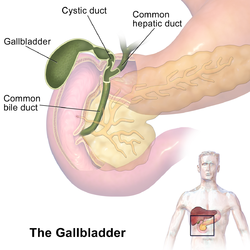
Back Galblaas Afrikaans مرارة Arabic ܡܪܪܬܐ ARC مراره ARZ Wisopi ATJ Öd kisəsi Azerbaijani Жоўцевы пузыр Byelorussian Kantong amperu BEW Жлъчен мехур Bulgarian পিত্তাশয় Bengali/Bangla
| Gallbladder | |
|---|---|
 Diagram of human gallbladder | |
 The gallbladder sits beneath the liver | |
| Details | |
| Precursor | Foregut |
| System | Digestive system |
| Artery | Cystic artery |
| Vein | Cystic vein |
| Nerve | Celiac ganglia, vagus nerve[1] |
| Identifiers | |
| Latin | vesica biliaris, vesica fellea |
| MeSH | D005704 |
| TA98 | A05.8.02.001 |
| TA2 | 3081 |
| FMA | 7202 |
| Anatomical terminology | |
In vertebrates, the gallbladder, also known as the cholecyst, is a small hollow organ where bile is stored and concentrated before it is released into the small intestine. In humans, the pear-shaped gallbladder lies beneath the liver, although the structure and position of the gallbladder can vary significantly among animal species. It receives bile, produced by the liver, via the common hepatic duct, and stores it. The bile is then released via the common bile duct into the duodenum, where the bile helps in the digestion of fats.
The gallbladder can be affected by gallstones, formed by material that cannot be dissolved – usually cholesterol or bilirubin, a product of hemoglobin breakdown. These may cause significant pain, particularly in the upper-right corner of the abdomen, and are often treated with removal of the gallbladder (called a cholecystectomy). Cholecystitis, inflammation of the gallbladder, has a wide range of causes, including result from the impaction of gallstones, infection, and autoimmune disease.
- ^ Ginsburg, Ph.D., J.N. (August 22, 2005). "Control of Gastrointestinal Function". In Thomas M. Nosek, Ph.D. (ed.). Gastrointestinal Physiology. Essentials of Human Physiology. Augusta, Georgia, United States: Medical College of Georgia. pp. p. 30. Archived from the original on April 1, 2008. Retrieved June 29, 2007.